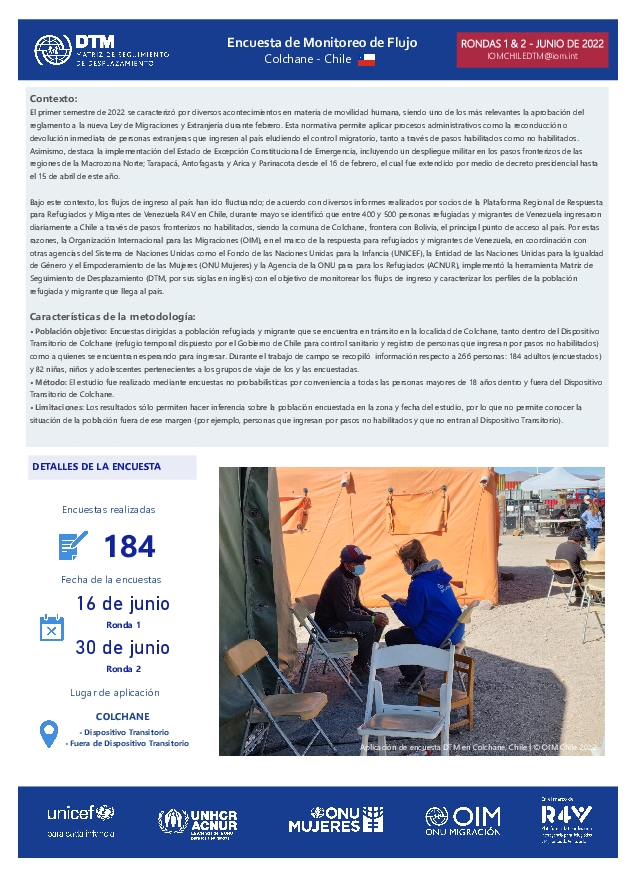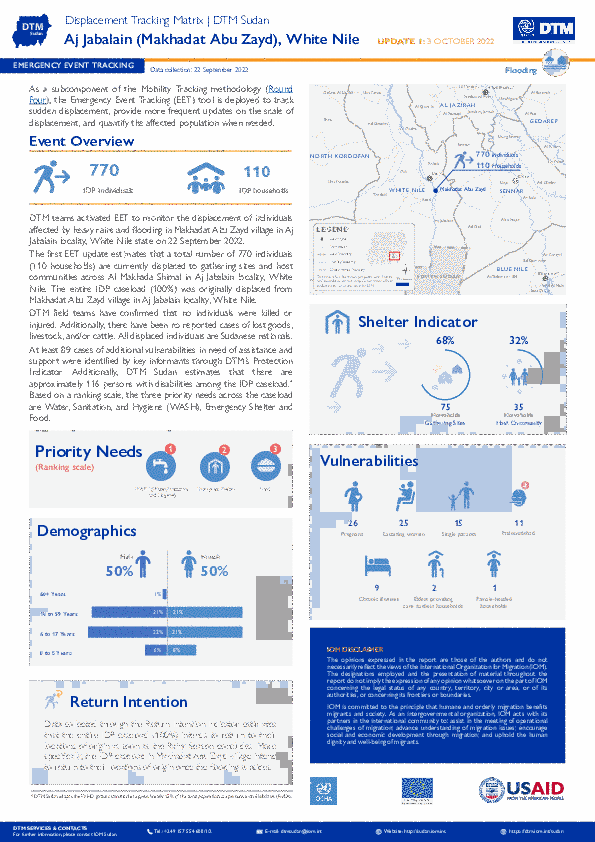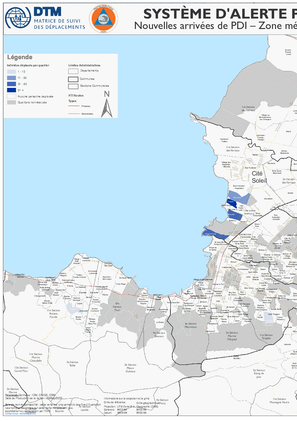-
Countries
-
Data and Analysis
-
Special Focus
-
Crisis Responses

Contact
iomdtmchile@iom.int
Language
Spanish
Location
Chile
Period Covered
Jun 01 2022
Jun 30 2022
Activity
- Flow Monitoring
El primer semestre de 2022 se caracterizó por diversos acontecimientos en materia de movilidad humana, siendo uno de los más relevantes la aprobación del reglamento a la nueva Ley de Migraciones y Extranjería durante febrero. Esta normativa permite aplicar procesos administrativos como la reconducción o devolución inmediata de personas extranjeras que ingresen al país eludiendo el control migratorio, tanto a través de pasos habilitados como no habilitados. Asimismo, destaca la implementación del Estado de Excepción Constitucional de Emergencia, incluyendo un despliegue militar en los pasos fronterizos de las regiones de la Macrozona Norte; Tarapacá, Antofagasta y Arica y Parinacota desde el 16 de febrero, el cual fue extendido por medio de decreto presidencial hasta el 15 de abril de este año.
Bajo este contexto, los flujos de ingreso al país han ido fluctuando; de acuerdo con diversos informes realizados por socios de la Plataforma Regional de Respuesta para Refugiados y Migrantes de Venezuela R4V en Chile, durante mayo se identificó que entre 400 y 500 personas refugiadas y migrantes de Venezuela ingresaron diariamente a Chile a través de pasos fronterizos no habilitados, siendo la comuna de Colchane, frontera con Bolivia, el principal punto de acceso al país. Por estas razones, la Organización Internacional para las Migraciones (OIM), en el marco de la respuesta para refugiados y migrantes de Venezuela, en coordinación con otras agencias del Sistema de Naciones Unidas como el Fondo de las Naciones Unidas para la Infancia (UNICEF), la Entidad de las Naciones Unidas para la Igualdad de Género y el Empoderamiento de las Mujeres (ONU Mujeres) y la Agencia de la ONU para para los Refugiados (ACNUR), implementó la herramienta Matriz de Seguimiento de Desplazamiento (DTM, por sus siglas en inglés) con el objetivo de monitorear los flujos de ingreso y caracterizar los perfiles de la población refugiada y migrante que llega al país.

Contact
DTM South Sudan, SouthSudanDTM@iom.int
Language
English
Location
South Sudan
Period Covered
Aug 01 2022
Aug 31 2022
Activity
- Registration
- Flow Monitoring
- Mobility Tracking
- Site Assessment
In August 2022, the monthly population count was conducted at Masna Collective Centre where 2,911 individuals/ 628 households were identified, and Naivasha IDP Camp where 7,543 individuals / 1,879 households were counted. The population of Naivasha IDP Camp decreased by 12 individuals since July 2022.

Contact
DTM South Sudan, SouthSudanDTM@iom.int
Language
English
Location
South Sudan
Period Covered
Jul 01 2022
Jul 31 2022
Activity
- Registration
- Flow Monitoring
- Mobility Tracking
- Site Assessment
In July 2022, the monthly population count was conducted at Masna Collective Centre where 2,855 individuals/ 615 households were identified, and Naivasha IDP Camp where 7,555 individuals / 1,883 households were counted. The population of Naivasha IDP Camp decreased by 160 individuals since June 2022.
Oct 03 2022
Print
Countries in this response
- Active DTM operation
- Past DTM operation

Contact
DTM Sudan; dtmsudan@iom.int
Language
English
Location
Sudan
Snapshot Date
Sep 22 2022
Activity
- Mobility Tracking
- Event Tracking
As a subcomponent of the Mobility Tracking methodology (Round Four), the Emergency Event Tracking (EET) tool is deployed to track sudden displacement, provide more frequent updates on the scale of displacement, and quantify the affected population when needed.

Contact
DTMAfghanistan@iom.int
Language
English
Location
Afghanistan
Period Covered
Aug 16 2022
Aug 31 2022
Activity
- Flow Monitoring
The snapshot captures present mobility and displacement trends between Afghanistan, the Islamic Republic of Iran and Pakistan.
Carte des Nouvelles arrivées des PDI dans la zone métropolitaine de Port-au-Prince, du 30 août - 3 septembre 2022.
Carte des nouveaux déplacements – Zone métropolitaine de Port-au-Prince – 30 août - 3 septembre 2022.
This Middle East and North Africa (MENA) report summarizes mobility restrictions at airports, land, and blue border crossing points resulting from the mitigation measures implemented in response to the COVID-19 pandemic.
Contact
DTM Yemen, iomyemendtm@iom.int
Location
Yemen
Activity
- Mobility Tracking
- Event Tracking
Period Covered
Sep 25 2022 -Oct 01 2022
IOM Yemen DTM’s Rapid Displacement Tracking (RDT) tool collects data on estimated numbers of households forced to flee on a daily basis from their locations of origin or displacement, allowing for regular reporting of new displacements in terms of estimated numbers, geography, and needs. It also tracks returnees who returned to their location of origin.
From 1 January to 1 October 2022, IOM Yemen DTM tracked 8,960 households (HH) (53,760 Individuals) who experienced displacement at least once.
Between 25 September and 1 October 2022, IOM Yemen DTM tracked 36 households (216 individuals) displaced at least once. The majority of people moved into/within the following governorates and districts:
- Marib (28 HHs) – Marib City (20 HHs), Marib (8 HHs) districts. Most displacements in the governorate originated from Shabwah and Al Hodeidah.
- Ad Dali (3 HHs) – Al Azariq (2 HHs), Qatabah (1 HH) districts. Most displacements in the governorate originated from Taiz and Ad Dali.
- Al Hodeidah (2 HHs) – Al Khukhah (1 HH), Hays (1 HH) districts. All displacements in the governorate orginiated from Taiz.
- Shabwah (15 HHs) – Ataq (12 HHs), Nisab (3 HHs) districts.
- Taiz (6 HHs) – Maqbanah (3 HHs), Mawiyah (2 HHs), At Taiziyah (1 HH) districts.
- Al Hodeidah (4 HHs) – Bayt Al Faqih (3 HHs), Az Zaydiah (1 HH) districts.
Population Groups
Survey Methodology
Unit of Analysis Or Observation
Type of Survey or Assessment
Keywords
Geographical Scope
Administrative boundaries with available data
The current dataset covers the following administrative boundaries


